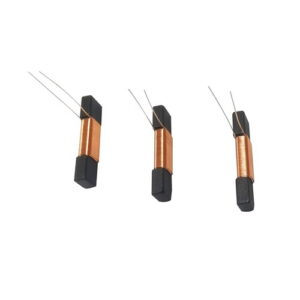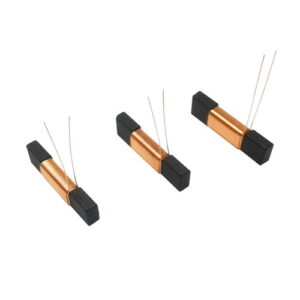The magnetic rod-type smart pen coil is an application of inductance and exhibits characteristics such as allowing DC to pass through while blocking AC. Therefore, magnetic rod smart pen coils are used for current interruption, signal shielding, resonance, peak suppression, and more. They are different from other types of coil inductors, such as toroidal and E-core inductors.

Due to the cylindrical shape of the magnetic rod smart pen coil and its high saturation characteristics, it can withstand high currents. The special material used also has a high Curie temperature, allowing it to work for a long time without heating. Therefore, magnetic rod-type smart pen coils are commonly used in vehicle circuits, such as ignition systems and magnetic switches.
The cost of magnetic rod-type smart pen coils is higher than that of E-core inductors but lower than that of toroidal and shielded inductors. Since inductance is wound first, coils with larger wire diameters can be wound, unlike other types of inductors where it may not be possible due to large wire diameters. The magnetic saturation of inductance is high, allowing it to withstand currents of several tens of amperes, and it has low resistance, making it irreplaceable by other types of inductors. Therefore, in high-current circuits, other types of inductors cannot be used as substitutes for smart pen coils.

Both magnetic rod-type and toroidal smart pen coils are insert-type inductors. Firstly, in terms of structure, toroidal coils usually have two sets of windings, but they also have a special inductor. On the other hand, magnetic rod sensors have only one set of wires, like a single coil wound around a magnetic rod, with a plug pin at each end of the magnetic core. Secondly, in terms of manufacturing processes, magnetic rod sensors are manufactured separately and then inserted into the coil and fixed with glue. Typically, magnetic rod sensor coils are wound using coil winding machines, while the manufacturing process of toroidal inductors mainly involves wire winding, gluing, coding, terminal trimming, testing, and more.
Lastly, in terms of inductance characteristics, toroidal inductors’ performance includes filtering, energy storage, and choke coils. Magnetic rod-type smart pen coils have the characteristics of low inductance, high Q value, magnetic saturation, and large conducting current, while also providing good shielding effects. Magnetic rod-type smart pen coils are generally made of brass material.